How to make a sewer of a country house with your own hands: the best schemes and options for arranging
Is it difficult for you to imagine your own private house or cottage without autonomous water supply and sewage? Agree that a well-maintained home ownership is many times more comfortable for living than a building without all amenities. But you do not know where to start and how to implement your plan?
We will help you deal with this issue - the article highlights the popular schemes and options for arranging the sewer system. The planning stage, the selection of a treatment plant and the order of work are considered in detail.
Contrary to popular belief, the do-it-yourself sewer of a country house can also be perfectly equipped. If you correctly design and build a system, then it will serve no worse than a professional one. For a better understanding of the material, we selected schemes, thematic photos and videos with expert advice.
The content of the article:
How does a typical sewage system work?
"Facilities in the yard" can satisfy only if it comes to a summer cottage without running water, where the owners appear occasionally and not for long.
Improvement of a residential building primarily involves the installation of water supply and sewage. They are being designed at the same time. If the water is already connected, then the sewage system is “adjusted” to the existing network.
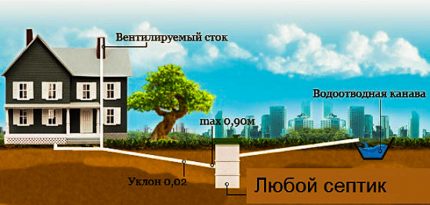
Option development sewer system wiring usually carried out at the design stage of the building and constructed during the construction process.
If necessary, you can, of course, perform these works both in the already built house and on the equipped plot, but it will be more troublesome and costly.
You need to know that the system consists of two interconnected elements:
- External sewage. It is located outside the building and includes a pipeline connecting to a centralized sewage system, or to a sewage treatment plant. The latter can be of any type.
- Domestic sewage. This is a construction of pipes connecting the taps of all plumbing fixtures located inside the building into a single system.
Both parts of the sewage system perform a common task and function in concert.
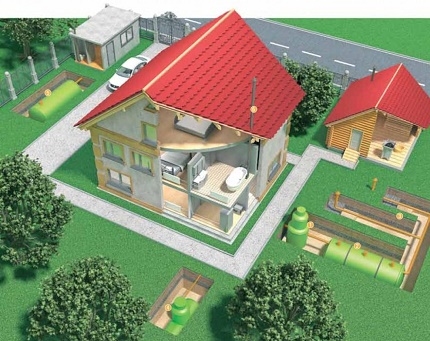
Principles of designing a sewer in a private house
The local sewage project for a country house should be as simple as possible in order to minimize the number of errors that are possible during installation. Such a scheme can be developed independently, based on drawings on the Internet. And it’s better to entrust the specialists with a complex project.
A simple sewer of a private house consists of typical elements: pipes connected to plumbing fixtures, a riser, an external pipeline and a storage or treatment plant into which all the sewage from the house is drained.
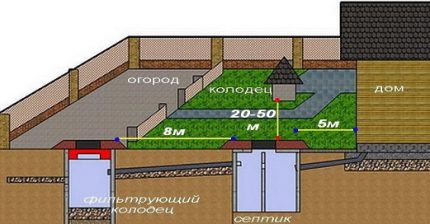
When developing a sewer system plan, they are guided by several principles:
- In a one-story house, it is reasonable to place the rooms in which the plumbing fixtures are installed nearby (kitchen, bathroom, toilet).
- Blocks with plumbing are better located closer to the point of output of pipes to the street.
- In a two- or three-story residential building, rooms with plumbing are planned one above the other to connect all the equipment to a common riser.
- The internal sewage scheme of the house should be designed so that the number of connections is minimal. This will positively affect the efficiency of the sewer system, and the likelihood of blockages and malfunctions will decrease. The main rule: simple - more reliable.
- Sometimes the layout of the house is such that it is necessary to develop a complex communication scheme. An alternative is the installation of several simple systems with separate external pipelines and sewage treatment plants.
There are houses where the drainage system must be used sewage pumping station . In such cases, it is better not to save on technology, and entrust the design and installation of complex sewage to a country house with professionals.

When developing a sewage project, several important factors should be considered:
- The arrangement of the water supply system. It can operate from a private hydraulic structure (a well or a well with a pump) or a centralized network.
- Number and type of plumbing fixturesto be installed, as well as how much each of them consumes on average water.
- Distance from home to septic tank, the volume and number of chambers, the total length of the pipeline.
- Cleaning method drive, the presence / absence of access roads for special construction equipment.
- Climate and hydrogeological features of the area: soil freezing level, ground water cover, site relief.
In the design process, all the nuances are taken into account: the layout of the sewage system (internal and external), the type and quantity of materials, turns, joints and joints.
If the local sewage system provides for the installation of additional equipment (pumps, compressors or aerators for septic tanks), then the locations of the devices are also indicated on the drawings.
Let us analyze in more detail the design and construction features of the external and internal sewer system.
External sewer system
In the simplest version, an external sewage system connects the building with a centralized sewage system. Unfortunately, it is far from always possible to implement it.
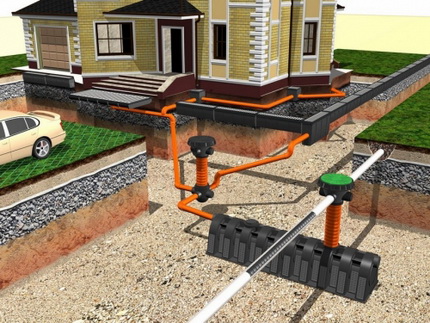
The treatment facilities independent of centralized networks include various types of storage tanks, which we will consider later.
Option # 1 - cesspools of different designs
The cheapest option is to build a system supplemented by a well with a filter bottom. It is a pit, the walls of which are laid bricksimilar material or even tires. The bottom remains free, a meter filter of sand and gravel with a thickness of 1 m is poured onto it.
Sewage enters the tank, the liquid is partially absorbed into the underlying soil layers. Solid sediment that has not passed through the soil filter accumulates and is periodically pumped out. The advantage of such a scheme, in addition to low cost, is considered to be the extreme simplicity of the arrangement.
But there are a lot of shortcomings. First of all, this is the danger of environmental contamination by effluents, the threat of which arises from flooding of the system with flood waters or from depressurization of structural parts. According to the standards, only gray drains are allowed to be cleaned in this design - contaminated water from the kitchen, baths, etc.

Installation of a cesspool without a bottom is possible only on sandy soils with sufficient filtration properties to absorb treated wastewater. Between the conditional bottom of the absorbing well - this sewer structure and the level of groundwater in the area should not be less than a meter thick soil.
It is advisable to build a cesspool in the country house or for the sewerage of a country house in which the minimum number of plumbing fixtures is installed.
The most simple option is the implementation of concrete rings, for the construction of which several standard steps are performed:
Sealed tanks or reservoirs are safer because they involve the accumulation of effluents and their periodic pumping. The liquid is unable to seep into the surrounding soil layers.
Such drives can be installed under any geological conditions of the sites, even at high GW. They do not create problems for prudent owners who are considering how best to make a sewer for their own home.
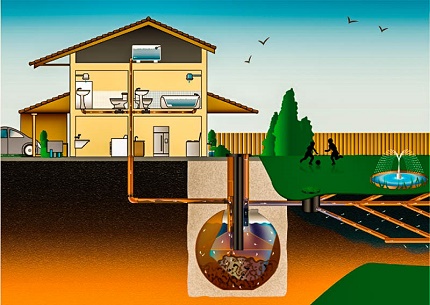
Professionals advise paying special attention to the volume of installed capacity. To pump it out, you will have to call the scavengers, who most often charge a fee for the call, and not for the volume.
Given that the machine pumps out 8000 liters of fluid at a time, it makes sense to choose a tank of exactly this volume. But the cost of such a tank is usually high. Therefore, it is worthwhile to choose a compromise option in order to optimize the costs of the services of dump trucks. We recommend that you deal with features of the choice of capacity from plastic for a septic tank.
In the construction of cesspools, a variety of materials and finished structures are used:
When building a cesspool or sealed storage septic tank, it makes sense mount check valveto prevent wastewater from overflowing the sewage treatment plant into the house. The valve will also protect against rodents that can get into the room through pipes.
Option # 2 - septic tanks of anaerobic type
Anaerobic bacteria, which do not need oxygen in the process of life, are used to clean the waste fluid. Structures, as a rule, have two or three, rarely a larger number of chambers in which the effluents are split and treated.
After the septic tank, additional purification of the liquid in filter wells, in filtration fields and the like. Devices can be installed on sandy and gravel soils.
Septic tanks of this type can be made independently of several concrete, metal or brick chambers. You can purchase a finished construction made of plastic. Manufacturers offer a large number of different models of such septic tanks.
The advantages of the equipment include a fairly high degree of purification, good throughput and the possibility of self-manufacturing.
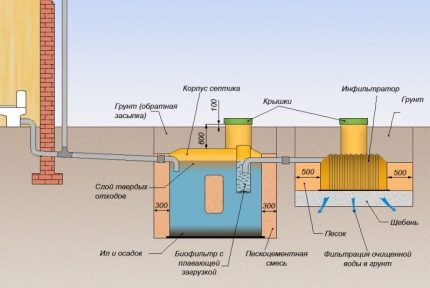
Of the shortcomings, you need to take into account the rather high cost of finished models, the need for regular cleaning of the septic tank. True, it will be required to do this much less often in comparison with the drive. But in any case, when determining the place for the septic tank, you need to take into account that the sewage machine should freely approach it.
Another minus is the obligatory arrangement of post-treatment of water coming from the septic tank.
Option # 3 - aerobic treatment plants
Perhaps the best option for organizing an autonomous sewage system in a private house is a high biological treatment station.They are much more compact than anaerobic septic tanks, they treat wastewater by 98%, that is, after-treatment is not required later.
Filtered water can be discharged into ponds, ditches or into storage wells, so that later it can be used for household needs. The unpleasant smell near such structures is completely ruled out.
The disadvantages of such stations include the energy intensity of the equipment. To work, he needs a continuous supply of oxygen, which is pumped using special compressors powered by electricity. Another disadvantage is the high cost of the system. However, you need to understand that significant investments in the future pay off.
Aerobic treatment plants do not require significant operating costs, while an almost free cesspool, for example, requires constant expensive pumping, and facilities with a filter bottom "clog" after a while and stop absorbing water. We have to fill up such a hole and equip a new one.
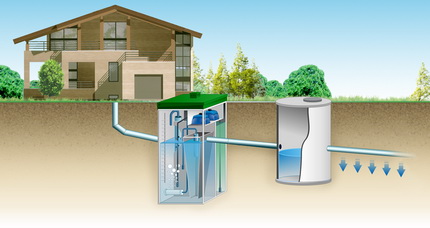
When choosing a type of treatment plant suitable for their site, experts recommend not to rush and to calculate all the options for arrangement. Do not try to save as much as possible on the septic tank. In the future, such savings could turn into serious problems.
How to choose a treatment plant?
The deciding factor should be the operating conditions of the equipment, in addition, special attention should be paid to:
- Frequency of use of the future sewer system. If we are talking, for example, about a country house, where people appear periodically, there is no point in using high-tech equipment. Bacteria in the absence of the nutrition that the wastewater supplies them will simply die.
- The daily volume of drains. This indicator characterizes the required throughput of the selected treatment facilities. It is affected by the number of people constantly present in the house, the number and type of plumbing fixtures, etc.
- The ability to connect equipment to electricity. This is important if you plan to install an aerobic treatment plant.
- Budget, which is planned to be spent on the purchase, installation and use of a septic tank.
- Type of soil and level of subsoil water. If the latter is too high, the operation of the septic tank may be difficult or simply impossible, since the purified liquid will have nowhere to go. The same thing happens when installed in clay soil, which does not absorb or pass water.
Determining the type of treatment equipment is a responsible undertaking. The effectiveness of the functioning of the entire system depends on this. When developing a project, some difficulties may arise associated with hydrogeological features and terrain.
In particular, the selection of a treatment plant option for an independent sewer network is selected taking into account hydrogeological and geological conditions:
Depending on the type of soil, after-treatment systems for septic tanks are designed. It can be filtration fields or absorbing wells. The former should be used on sandy and sandy loamy soils, and the latter on clay and loamy soils.
The groundwater level also affects the choice of the type, material of the septic tank, the features of its installation.
An important point - the place for installing the septic tank must comply with sanitary standards. First of all, it should be at least 5 m from the apartment building, and 50 m from the drinking water intake point, for example, from the well. It is advisable to install a septic tank at the lower point of the site.
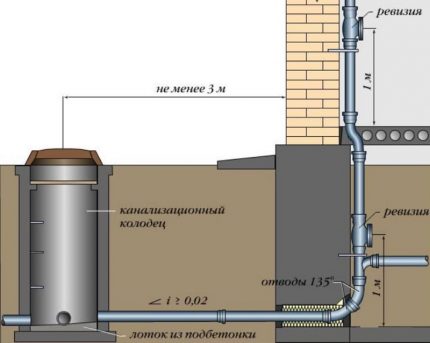
This will make it possible to use the natural relief to create a slope for the pipes. This will facilitate the work. It is advisable to conduct a pipeline to the sewage treatment facilities of a private house in a straight line, since each turn can be considered as a potentially hazardous area for blockage.
It is obligatory to be equipped here manhole. The connection of the supply pipe and the septic tank is carried out by means of a rubber cuff. So it will remain intact after seasonal shifts of soil.
Arrangement of an external sewer system
The external sewage project is being developed so that it is as close as possible to the septic tank and the pipeline section is straight. As for pipes, the choice in favor of polymers is rational.
Selection of required materials
Most homeowners choose synthetic sewer pipes. They are suitable for both internal and external wiring. These are durable corrosion resistant products. With strong mechanical stress, they are able to deform, but rarely crack.
So, on the smooth inner walls of the sewer PVC and HDPE pipes less accumulation of deposits than on metal surfaces. Due to this, the highway is less prone to blockages.
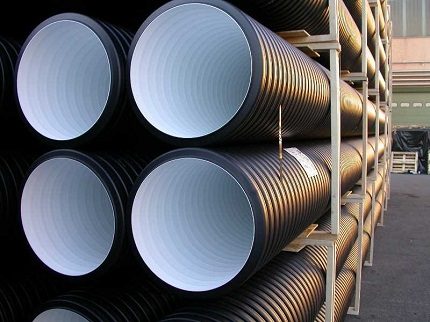
Products made of polymers are resistant to acids and alkalis. Reactive drains do not harm the pipes, which positively affects their life. Also, polypropylene and polyvinyl chloride well tolerate high temperatures (up to 60-100 ° C).
For the installation of the pipeline, connecting parts, tees, fittings will be required. To make it convenient to inspect and repair the sewer system, it is necessary to take care of the availability of revision niches, inspection wells and hatches for them.
It is also necessary to choose the right joint sealant. It is best to give preference to a special silicone composition with antiseptic additives.
Features of the installation of external networks
In general, the installation of sewage systems is not much different from the laying of water pipes, but there are differences.First of all, the sewage system does not always need to be insulated. This is explained by the fact that the liquid passes through the pipes without stopping and, theoretically, they stand empty most of the time.
In addition, the effluents leave the internal system with a temperature of at least 15 ° C, while moving through the pipeline, they simply do not have time to freeze.
Therefore, sewer pipes can be laid about 0.5 m above the freezing boundary of soil layers. But in areas with cold winters it is better to insulate them for safety. This can be done in any suitable way by analogy with the water supply.
You can not use mineral wool, which gets wet and at the same time loses its insulating properties. A good option is polystyrene foam, foamed polyethylene with a foil-coated outer shell.
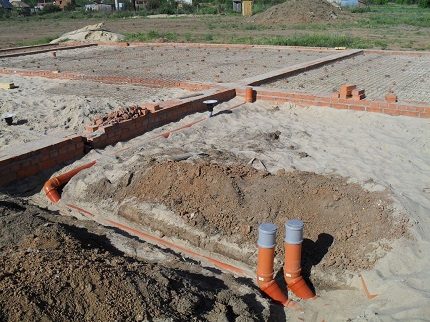
Laying of external sewer pipes is carried out under a slope, which allows drains to move by gravity. For plastic parts, the minimum slope is 0.8 cm per meter of pipe.
The best option is 1.5 cm per meter. For asbestos pipes, these figures are respectively 1.5 and 3 cm per meter. A larger slope is not recommended, otherwise the liquid will merge quickly, and large inclusions can be deposited on the walls and clog the pipe. Detailed calculations of the slope of the sewer pipe with the formulas we have given in this article.
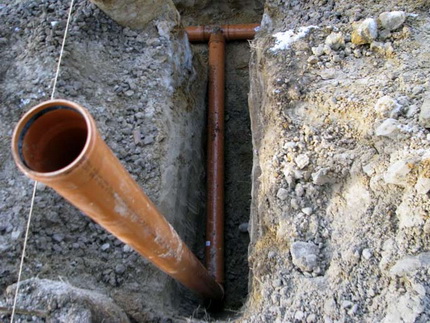
Experts remind that the laying of pipes of the external sewage system starts from the point of insertion into the centralized sewage system or from the septic tank and moves towards the house.
Installation includes several stages:
- A trench of a pre-calculated depth is excavated. It is advisable to immediately maintain the desired slope. It is not advisable to pour the finished trench. This is quite time-consuming, given the need for additional bottom compaction.
- Sand cushion is poured. The height of the structure is 0.1-0.15 m. The sand is well shed with water, and then carefully tamped.
- Pipes are placed on the prepared base. The presence of a given slope is checked.
- A layer of sand is filled up with a height of about 0.1 m. The backfill spills again and is compacted.
- Backfill is carried out.
During the installation of external sewage, you need to remember about the need to equip viewing wells. They are placed at all corners and in areas where there are differences in depths. In addition, such structures are also installed in direct sections every 25 m.
Domestic sewage system
An internal sewage system is a collection of pipes and fittings that connect them. This whole system provides the discharge of wastewater from plumbing equipment to an external sewer pipe.
Home network device
A riser is used to drain the drains - a structure can be one for the entire building or several. The latter is practiced when the area of the house is large or the bathrooms are located at a considerable distance from one another.
A riser is a vertically located pipe running from the basement of the building to the roof. The lower part of the part is connected to a drainage pipe, which is connected to an external sewer. The upper section of the riser rises above the roof, where it rises at least 50 cm.
The upper part of the riser is displayed on the roof. It is not sealed, but well covered from rain and dirt. This is necessary, because at the moment of water discharge, rarefied pressure is created in the system, and air can squeeze out into the room.
An alternative would be to install an aeration valve that lets air through, but protects the house from the sewer stink.
Plumbers allocate a number of rules, which are strictly not recommended to be violated:
- The diameter of each of the supply pipes cannot be less than the supply of plumbing equipment.
- The toilet is connected to the riser only separately from all other devices.
- All plumbing fixtures should be located no further than 3 m from the riser, the toilet should not be further than 1 m.
- There may be several devices on the outlet pipe of the proper diameter. In this case, the toilet should be connected first. All other equipment is included in the circuit above this point.
- The diameter of the pipe extending from the toilet is always not less than 100 mm. Inlets longer than 3 m must have a cross section of at least 70 mm, longer than 5 m - at least 100 mm.
In addition to a competent choice of pipe diameter for the prevention of blockages, it is important to correctly form the corners. For example, 90 ° turns are unacceptable, since blockages will inevitably form in this place and pipes will quickly become clogged.
Sections with 90 ° turns of the pipeline are thought out in such a way as to use 2-3 bends, which are set at 30-45 °. This is necessary to avoid the accumulation of sewage in the knees and blockages.
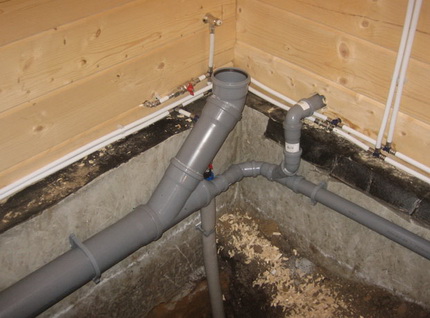
Sometimes "craftsmen" are advised to withdraw fan pipe in the system of general ventilation. This does not need to be done categorically, otherwise the house will be filled with extremely unpleasant odors, which will be impossible to remove.
When arranging a sewage system, it is worth thinking about sound insulation. Water moving through pipes can make a lot of noise. The best option is wrapping parts with mineral wool. After that, they are placed in drywall boxes.
At the same time, it is important not to forget about the inspection hatches, which are installed at all turns and every 15 meters. Another important point: the mandatory presence of a check valve. It is installed on the pipe connecting the septic tank to the house drainage system.
If this is not done, with a possible overflow of the tank, sewage will rise up the pipes and flood the basement or lower floor.
Design Features
In order to properly perform the wiring of the sewage system in a private house, you need to draw up a competent project. To begin with, a scheme is performed on which the installation locations of plumbing fixtures are indicated.
Before this, you need to consider at what distance from the riser the equipment will stand, how to connect to the sewage system and what should be the cross-section of pipes suitable for it.
It is also important to determine the type of sewage system. You can choose from two options: gravity and pressure. In the first case, the pipes are laid so that the drains flow "by gravity."
There are regulations governing the minimum slope of such pipes. For parts with a cross section of 50 mm, a slope of 3 cm per meter of pipeline is selected, for a pipe of 100-110 mm in diameter - 2 cm.
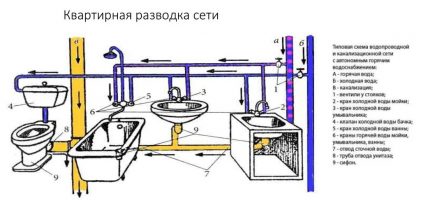
If a part with a cross section of more than 160 mm is selected, they are laid with a slope of not more than 0.8 cm per meter. In addition, you must also take into account the height difference. So for the toilet, it should be 1 m, for the rest of the equipment - 3 m. If these figures are exceeded, it is necessary to equip additional ventilation at the ends of pipes that are suitable for the devices.
For the implementation of the pressure sewer project, a pump is required, so the slope for pipes is not needed. We recommend that you familiarize yourself with types of sewage pumps and features of the choice of such equipment.
To determine the diameter of the supply pipe for each plumbing device, a one-time drain is calculated. This can be done based on its technical characteristics.
Practice shows that most devices can work with a pipe with a cross section of 50 mm. The exception is the toilet, it will require a 100 mm pipe. In addition, you need to identify the location of the riser.
Usually it is mounted in a toilet, not far from the toilet. If you plan more toilet rooms or “wet” areas are distributed around the house, the number of risers will have to be increased.
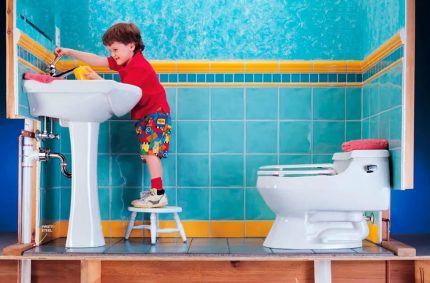
Installation of an internal network
Internal wiring begins to be mounted with risers. The ends of the pipes are taken to the basement and to the roof. The lower section is connected to a horizontally laid pipeline that discharges effluents to a treatment plant.
Then, to the risers are connected taps from the toilets, each separately. Further higher than the toilet bowls were connected, pipes from other appliances are supplied.
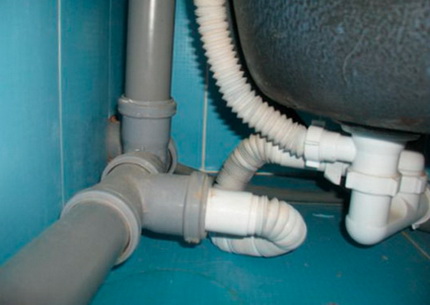
Siphons are installed on all plumbing equipment, which are then connected to the supply pipes. These are the main stages of arranging the internal network. All joints made must be airtight, pipes are rigidly fixed to ceilings or walls.
For the arrangement of intra-house sewerage, it is optimal to use PVC pipes with sockets. They are easily cut with a special saw and connected with sockets. A corrugated pipe is used at the sewer outlet to the street, which is well resistant to possible soil movements.
To connect parts to a single network, shaped elements are used to help arrange turns, switch from one diameter of the part to another, etc. To facilitate the process of connecting the pipes, the sockets are heated in hot water.
All plumbing equipment is connected via siphons. This is the name of a bent pipe in which a water seal is present, eliminating the appearance of a smell of sewage in the room.
These devices can be metal or plastic. When choosing, it is better to focus on the material of the sewer pipes. If they are polymer, then it is advisable to install plastic siphons.
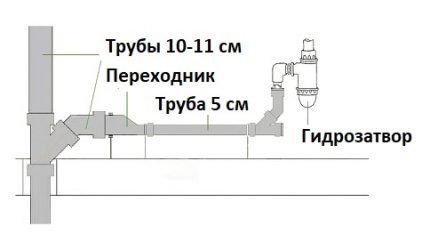
Siphons can be corrugated, have a bottle or tubular shape. Innovative development - dry water seal.
Corrugated Siphons the cheapest. They are convenient in installation and operation, resistant to aggressive chemicals. However, it is undesirable to connect them to sinks, which often pour hot liquids.
Bottle Siphons similar in shape to a flask. This can be both an advantage and a disadvantage, since objects accumulate at the bottom of the device.If a ring or valuable item falls into the sink, it is easy to remove. On the other hand, blockages can form in the siphon due to this form.
Pipe siphons have a U-shape. Solid particles can also accumulate at the bottom of such a siphon. They are removed using a special knee.
There is a small amount of water in the trap of the device, so it can evaporate and cease to protect against the smell of sewage.
Dry siphons. They dry after the water drains into the sewer. The devices are equipped with an elastic membrane that prevents air from entering the pipes into the room. Such a siphon will cost more than less technological counterparts, but with it there is no problem of evaporation of water from a water seal.
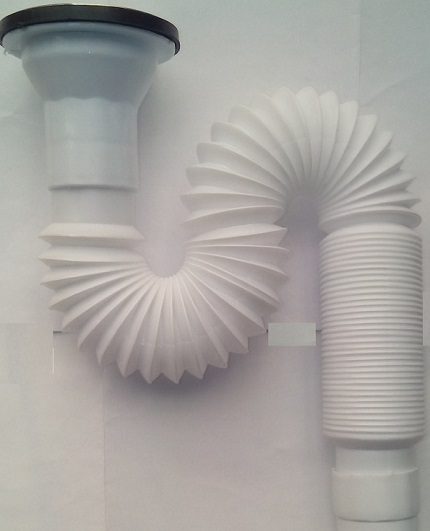
The siphon may not work in two cases:
- Lack of ventilation. Under such conditions, the vacuum will simply suck out the liquid from the hydraulic seal and thereby open it.
- Siphon drying. This occurs with rare use of plumbing. To avoid odors, siphons should be closed with a stopper or cloth.
Sewer pipes and risers often mask with decorative boxes. To prevent noise during the operation of the system, it is insulated with mineral wool or other suitable materials.
Arrangement of sewer outlet
To combine the internal and external parts of the sewage system, a unit is called a discharge. He settles in the foundation of the building, as a rule, still in the process of construction.
To do this, when laying the foundation, a hole is left in a certain place. Its diameter is equal to the cross section of the sleeve, which, in turn, is slightly larger than the diameter of the sewer pipe.
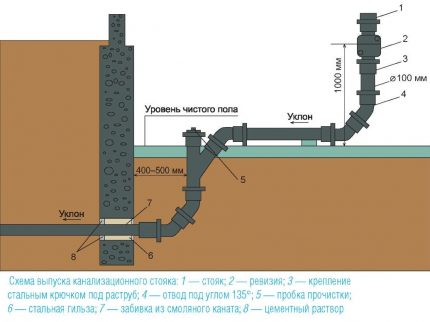
Typically, a pipe section is used for the sleeve, the cross section of which is 150-160 mm.It is important to choose the length of the element. It should protrude approximately 0.15 m on both sides of the foundation. A pipe is inserted inside the sleeve, to which an internal network is connected from the inside, and an external one from the other end.
An important point is the insulation of the structure. This procedure is performed to eliminate the possibility of freezing of the sewer.
Conclusions and useful video on the topic
A correctly selected sewer scheme of a country house, accurate measurements and calculations, high-quality materials and competent installation are the key to the effective operation of the future system.
However, some issues are difficult to figure out on your own. We offer a useful selection of videos on the arrangement of an autonomous sewer system of a private house.
When calculating the slope of the external sewage pipes, mistakes are often made. Check out the video that will help you navigate when developing a project and installing a pipeline:
The feasibility of insulation of external sewer networks:
A short lecture explaining the principle of the system, especially the choice of circuit:
Video materials on the ventilation system of the sewer system:
The first and most crucial stage of construction is design. The more detailed and more accurate the sewage system of the house is developed, the easier the operation of the finished system will be.
If it turns out that the conceived event is too complicated, you can always turn to professionals for help. They will complete the project and carry out installation work of any complexity.
Have you built a sewer for your house on your own project? Or are you just preparing a project and have any questions? Ask them under our article - our experts and other site visitors who own the information will try to help you. It is better to spend time and effort clarifying the nuances than subsequently encounter problems. Effective autonomous sewage is not so difficult.

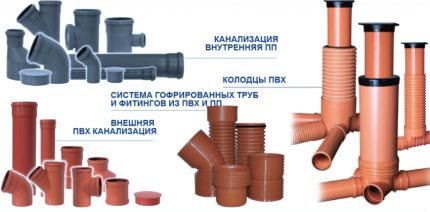
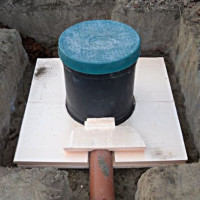 Do-it-yourself sewerage in the country: how to correctly make a local sewer
Do-it-yourself sewerage in the country: how to correctly make a local sewer 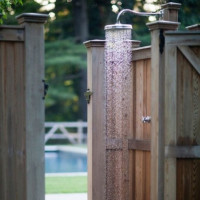 How to make a summer shower with your own hands: schemes of common designs
How to make a summer shower with your own hands: schemes of common designs  DIY garden shower: technology features and main stages of construction
DIY garden shower: technology features and main stages of construction 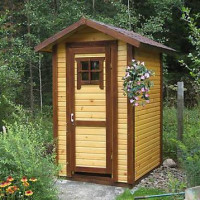 DIY toilet in the country: step-by-step instructions for building
DIY toilet in the country: step-by-step instructions for building 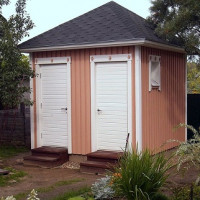 The design of the country toilet with shower: the choice of the scheme and instruction on the construction
The design of the country toilet with shower: the choice of the scheme and instruction on the construction 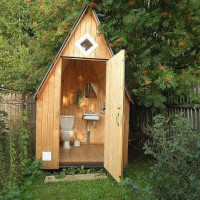 Drawing of a country toilet: popular building schemes for an independent project
Drawing of a country toilet: popular building schemes for an independent project  How much does it cost to connect gas to a private house: the price of organizing gas supply
How much does it cost to connect gas to a private house: the price of organizing gas supply  The best washing machines with dryer: model rating and customer tips
The best washing machines with dryer: model rating and customer tips  What is the color temperature of light and the nuances of choosing the temperature of the lamps to suit your needs
What is the color temperature of light and the nuances of choosing the temperature of the lamps to suit your needs  Replacement of a geyser in an apartment: replacement paperwork + basic norms and requirements
Replacement of a geyser in an apartment: replacement paperwork + basic norms and requirements
I advise you to think about the sewage system in advance when the house and all outbuildings are only being designed. It is important that the cesspool is removed from the foundation and as far as possible from the well or well. I have the cheapest and most effective option: a cesspool with a filter bottom, and a PVC pipe goes directly from under the foundation of the house. And of course, this whole system is sprinkled with earth. Frosts are not terrible; from time to time I call out sewage pumps to pump out sediment from the pit.
I have a sewer in my own house with a simple cesspool. The cesspool is located outside the fence of the house plot. There is a preliminary pit at the house, into which sewage from the kitchen, bathroom and toilet flows through different pipes. The pit is lined with brick, the bottom is concreted, in which a hollow is arranged that directs the flow of sewage into the sewer pipe connecting this pit to the cesspool. The connecting pipe is plastic, with a diameter of 100 mm, its length is 12 meters. A cesspool of concrete rings with a diameter of 1.5 meters. The depth of the pit is 4 rings, which allows you to accumulate drains for a month, and then transported by a tank truck. Works great.
Every month, pumping out a little expensive. Go bankrupt on suckers. Wasn't it better to put a septic tank?
Someone can tell, if you make a sewer according to the scheme when two Eurocubes are taken, why is the second Eurocube installed not at the same level, but lower?
Specifically for this case, one Eurocube is placed below the other so that when filling the first, excess liquid from one tank overflows into the second. That is, a series connection of the tanks using a special pipe.
I also advise you to pay attention to the strengthening of the erocubes with a metal grill; for the upper part (hatch), I advise you to use a wooden cover. This is a protective measure, if you plan to dig the tanks deep, then the grilles and the cover will take the bulk of the load on the weight of the soil.
In our house, sewer drains into a cesspool, and, as it is correctly noticed, this is a cheap way, but with its own troubles. In our old house, this pit was not even lined, and therefore it crumbled, when it was full, another was dug up. It should be noted that the toilet and bath were not installed in the house. I made a discovery for myself that it is better to use biological treatment plants. I am a supporter of protecting nature and its resources.
How much cheaper will a home-made septic tank be? And what do you say in terms of reliable home-made designs?
Hello. Homemade septic tanks will be much cheaper than buying a finished product. I can’t name specific numbers, since I don’t know which septic tank you need in performance, which of the ready-made solutions you need to compare. The site has a lot of material on the manufacture of concrete septic tanks for private homes.
You will need three cameras:
1. Sealed well with compressor and aerator;
2. Sealed sludge sump with drainage pump;
3. A drainage well without a bottom.
The cameras are interconnected by a corresponding pipeline, I attach the circuit for a visual understanding.